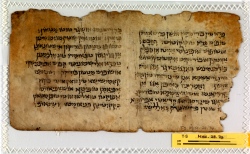Cambridge, University Library, T-S Misc.28.74
Origins
Byzantine, 11th c. or earlier.
Provenance
Found in Genizah of Ben Ezra Synagogue, Fostat, Egypt, and taken to Cambridge by S. Schechter, 1896–97.
Contents
Fragment of a Greek translation of Kohelet (Ecclesiastes).
Codicology
A single leaf of parchment, substantially intact but damaged along two edges; a little of the text has been lost. Overall dimensions: height 11.5 cm., width 22 cm. There is no indication that the leaf was bound in a codex: some sort of loose leaf arrangement should be envisaged. There is a small hole in the middle: the leaves were perhaps assembled on a spike or a string. There are traces of a central vertical fold
Palaeography
Byzantine square Hebrew characters. The written space measures 7.5 cm in height, and the lines are of variable length, 8–9 cm. 10 lines per column, 2 columns each side.
Bibliography
de Lange, Nicholas, Two Genizah Fragments in Hebrew and Greek, J. A. Emerton, S. C. Reif, Interpreting the Hebrew Bible: essays in honour of E. I. J. Rosenthal, Cambridge, Cambridge University Press, 1982, 75–83.
de Lange, Nicholas, Greek Jewish texts from the Cairo Geniza, Tübingen, Mohr Siebeck, 1996.
Niehoff-Panagiotides, Johannes, Rabbinische Lebenswelt und rabbinische Hermeneutik : die griechischen Juden in der Kairoer Genizah, Byzantion , 74, 2004, 51–109.
